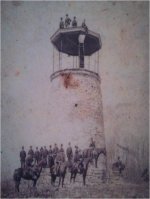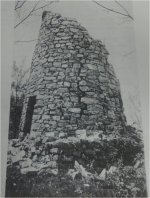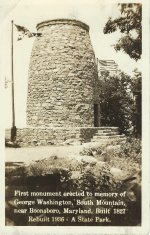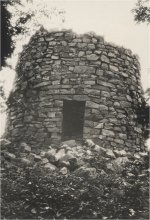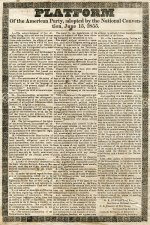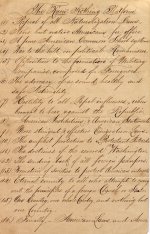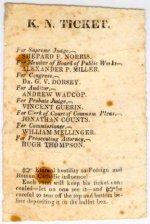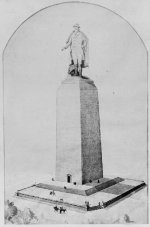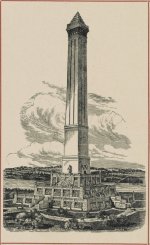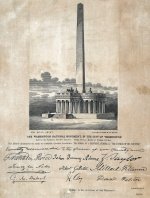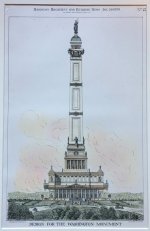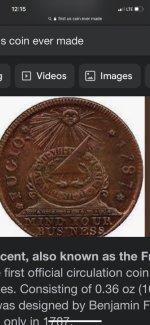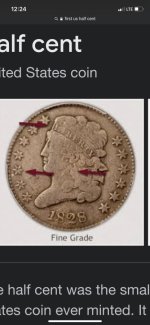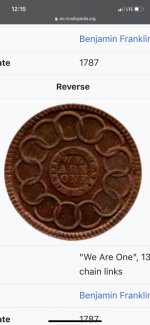Unfortunately, I have never been to Washington, DC. Being able to see certain architectural objects would have been helpful. I was originally planning on talking about two structures, with Washington Monument being one of those, and the Capitol Building being the other. The Capitol Building will have to wait for its own article.
Who, or what was the person we know as George Washington. What do we have in the image above? That sword is not Roman, it's a Tartarian sword. Her Phrygian hat should be properly called a Scythian one. Not quite Roman here, but sure appears pagan.


Lady Liberty looks different these days

Washington Monument+
The FirstFirst of all, the Washington Monument everyone knows, is not the first Washington Monument out there. The true "First" was built in 1829 in Boonsboro, Maryland. This MD Washington Monument is located 52.6 miles North-West from the main Washington, DC one. I understand that Boonsboro is not DC, but there is a reason I mention this 1829 dedication to the first president. And this reason is - it was built in one day.

Rather incredibly, the First Washington Monument was built by local residents in a single day. Some 500 Boonsboro residents assembled in the town square at 7:30 a.m. on July 4, 1827, and trekked two miles up to the hilltop. Work proceeded efficiently using stones gathered from the hillside, quickly dry set into place without mortar. By 4:00 p.m. the citizens had completed a 15-foot-tall tower and stood back to admire their handiwork. According to a contemporary observer, “At the conclusion of our labors, about 4 o’clock, the Declaration of Independence was read from one of the steps of the monument, preceded by some prefatory observations, after which several salutes of infantry were fired, when we all returned to town in good order.”
now it's 30 feet tall


Boonsboro Monument Construction
All labor was volunteer. Enjoy.On an eminence of the mountain ridge overlooking the town of Boonsboro can be viewed the remains of a monument for which the claim is made that it was the first to be erected to the memory of Washington. The monument was built of native stone lying about its site, comprising an area of several acres, which forms a kind of crown to the mountain fold. Skilled workmen, and in number, were not wanting. All labor was volunteer. The structure was circular grading to a narrower corniced top, and rose from an elevated square base to a height of thirty feet, with a spiral stairway through the center. A marble corner- stone in the base bore the inscription: "Built by Isaac C. Lutz, 1827," and a tablet was set facing the town on which was inscribed, "Erected to the Memory of Washington, July 4, 1827, by the Citizens of Boonsboro."
On the morning of the day of the dedication, the citizens of the community formed themselves in a column headed with the national colors and a fife and drum corps and proceeded to the summit to set apart the structure with becoming ceremony. The Torchlight of Hagerstown, bearing date of July 5, 1827, made a report of the original ceremony which comprises the contemporary record of it. This account is as follows:
The above photograph of the "Monument" shows a fixed up and repaired structure. Now let us look at some historical photographs of the same tower.
Oh, almost forgot, this is how you get to the top.

KD: I don't know about you, but to me it looks like somebody nailed a commemorative plaque to a wall of some medieval tower, and followed it up with a fairy-tale story. If that qualifies as building a monument, so be it. Hauling one ton rocks by hand up the hill (on volunteer basis) had to be an every day occurrence back in the day. The reason I mentioned this MD Washington Monument is because of the unrealistic time frame presented, especially when we compare it to the one below.
This MD Washington Monument Tower reminded me of another structure located fairly close, and called Norumbega Tower.

Sources:

Construction of the monument began in 1848, and was halted from 1854 to 1877 due to a lack of funds, a struggle for control over the Washington National Monument Society, and the intervention of the American Civil War. Although the stone structure was completed in 1884, internal ironwork, the knoll, and other finishing touches were not completed until 1888. A difference in shading of the marble, visible approximately 150 feet (46 m) or 27% up, shows where construction was halted and later resumed with marble from a different source. The original design was by Robert Mills, but he did not include his proposed colonnade due to a lack of funds, proceeding only with a bare obelisk. The cornerstone was laid on July 4, 1848; the first stone was laid atop the unfinished stump on August 7, 1880; the capstone was set on December 6, 1884; the completed monument was dedicated on February 21, 1885; and officially opened October 9, 1888.

Of course, we could blame the time frame on our normal government efficiency, but what if there was a different reason for these 50 years? Sounds like they should have used those volunteers from Boonsboro, MD, or, better yet, them fast builders from Seattle, who mastered 5,625 buildings in 18 months in 1889.
The below flags of the Native American "Know Nothing" party could explain the existence of a few interesting flags out there. Additionally, I do think that the true nature and what this Party really stood for was substituted with all the negativity you will find in this Party's description.


KD: Native American, Twenty One Years, Kensington. What?
The Know-Nothing Party, also known as the American Party, was a prominent United States political party during the late 1840s and the early 1850s.
KD: In my opinion, this confrontation between the Native Americans and Immigrants could be the true cause for the Civil War. Events like Philadelphia Nativist Riots aka Bible Riots (+link) were the precursor to the Civil War. See if you can figure out the mess in the image below. Are those Hussars supposed to be the Police?
The segment of the North American population represented by this "Know-Nothing Party" was later labeled as slave owners. They were known as the Confederates during the Civil War.
Did they own slaves? I think they did. "Businesspersons" of different skin color owned slaves of different skin color, of all skin colors. So did the Union "businesspersons". Remember who officially built Washington DC?
Above, I have indicated in bold - by 1860, the Know-Nothings collapsed. So, the Know-Nothing Party collapsed due to the lack of public support, and the very next year on 4.12.1861 the Civil War started? What a coincidence.
The Civil War officially ended in 1865. For some it did. I think that for those who, like Seattle, suffered their "Urban Fire" in June of 1889, the Civil War lasted at least that long. Miraculously in November of 1889, Washington Territory (or whatever it could have been called) became the 42nd state in the Union. There has to be a reason why we do not see any damage differences between Urban Fires, Earthquakes and the Civil War related damages. My guess - the cause was the same - the War. That said, we still won't know what weapons were used to wreck such a havoc on the 19th century American soil.

Anyways, this I'm not a professional researcher, and this stuff is too confusing for me. After looking through hundreds of images, and articles my head is spinning. This post was supposed to be about architecture. Instead I found myself going down the rabbit hole, which was not my intent. If someone wants to pick up this direction of the research, be my guest.

The darker lower portion of the completed obelisk indicates that 1848-1854 construction stage. I guess the darkness supposed to mean the unfinished portion of the obelisk being in the elements for 26 years. As you remember they were broke for 26 years and did not resume this honorable endeavor until 1880.
Essentially, what we have is some activity pertaining to each of the above presented heights. To put this into perspective, it allegedly took them at least 10 years to build the structure up. The obelisk was slowly creeping up, yet no other height was photographed? Unless the below drawing can account for all the missing photographs, we have an issue. May be I just failed to properly search for them... for whatever the below photograph can tell us, is not much. The stump of the obelisk is already up. @ISeenItFirst might have a different opinion on this, but I think this scaffolding has nothing to do with the actual erection of 156 feet of the obelisk stump.



Down under is allegedly the rig they used to work at the top, and to install the aluminum capstone, and lightning rods. Not sure what that gentleman in a Scythian hat is holding. I'm more occupied with his hat to be honest. The other question I have - where is the photo? This is 1884 after all. Eadweard Muybridge was taking photographs of running horses, and flying pigeons as early as 1878. Photo business was up and running for over 40 years in 1884, and photographs were being taken on regular basis for about as long.

Aluminum capstone

pretty sure two 1884 tops don't match, but who cares?

KD: Jumping ahead I will say, that there is no doubt about the obelisk having been built. It is obviously up, and we have a few intermediary photographs. That said I have two points to make:
On September 23, 1835, the board of managers of the society described their expectations:
Below is: Washington National Monument Society Membership Certificate printed by E. Weber & Company, Baltimore and issued by the Washington National Monument Society. Acknowledging the contribution of $1 by "Gideon Chadwell...in aid of the erection of the Washington National Monument". The document bears the printed signatures of Zachary Taylor, Elisha Whittlesey (General Agent), and George Watterston (Secretary). The left side shows a vignette of the monument complete with the "Pantheon" at the base (which was never built). The right side shows the monument very similar to the final design - with no Pantheon. Two other engravings appear at the top and the bottom of the document.
Apparently these certificates were used to fund the initial construction of the monument.

Construction continued until 1854, when donations ran out and the monument had reached a height of 152 feet (46.3 m). At that time a memorial stone that was contributed by Pope Pius IX, called the Pope's Stone, was destroyed by members of the anti-Catholic, nativist American Party, better known as the "Know-Nothings", during the early morning hours of March 6, 1854. This caused public contributions to the Washington National Monument Society to cease, so they appealed to Congress for money. The request had just reached the floor of the House of Representatives when the Know-Nothing Party seized control of the Society on February 22, 1855. Congress immediately tabled its expected contribution of $200,000 to the Society, effectively halting the appropriation. During its tenure, the Know-Nothing Society added only two courses of masonry, or four feet, to the monument using rejected masonry it found on site, increasing the height of the shaft to 156 feet. The original Society refused to recognize the illegal takeover, so two Societies existed side by side until 1858. With the Know-Nothing Party disintegrating and its inability to secure contributions toward building the monument, it surrendered its possession of the monument to the original Society on October 20, 1858. To prevent future takeovers, Congress incorporated the Society on February 22, 1859.
So, according to the official version all construction activities stopped in 1855 (54, 55... they need to make up their mind), and for the next 13, 14, 15 (pick one) years the monument looked like this.

Construction ResumptionConstruction resumed in 1879 under the direction of Lieutenant Colonel Thomas Lincoln Casey of the U.S. Army Corps of Engineers. Casey redesigned the foundation, strengthening it so it could support a structure that ultimately weighed more than 40,000 tons. The first stone atop the unfinished stump was laid August 7, 1880 in a small ceremony attended by President Rutherford B. Hayes, Casey and a few others. The president placed a small coin on which he had scratched his initials and the date in the bed of wet cement at the 150-foot level before the first stone was laid on top of it. Casey found 92 memorial stones ("presented stones") already inlaid into the interior walls of the first phase of construction. Before construction continued he temporarily removed eight stones at the 150-foot level so that the walls at that level could be sloped outward, producing thinner second-phase walls. He inserted those stones and most of the remaining memorial stones stored in the lapidarium into the interior walls during 1885–1889. The bottom third of the monument is a slightly lighter shade than the rest of the construction because the marble was obtained from different quarries.

Quote, "Looking at the above photograph, the eye of even a casual observer might be struck with the small size of the foundation of the monument, relatively to its enormous proposed height. This, indeed, was a vital defect in the original plan, and the Army engineers, in whose hands the work was placed by Congress promptly set about correcting it. They dug it out - it was mere rubble - at the corners and at the sides, shoring up the undermined structure meanwhile with great beams. They even burrowed a considerable distance under the obelisk itself, finally replacing the material thus abstracted with concrete, which was added in quantities sufficient to extend very largely the area of the foundation. The first foundation, indeed, covered only six thousand four hundred square feet, whereas the new one covered sixteen thousand square feet and was in effect a single block of solid stone - a monolith."
Guess what, those people in Baltimore better beware, for the same American architect Robert Mills designed their Baltimore Washington Memorial. And never mind that it was up since 1829, it might fall any moment now, for "the eye of even a casual observer might be struck" with the concept, that... something in this story is a bunch of BS.
Anyways, I'm not buying this "Mills was an incompetent architect" non-sense. A professional architect (with extensive track record) planning to build a 600 foot tall obelisk would know how to properly calculate the size of the foundation. But he was "no casual observer", what did he know?
Naturally the question I want to ask is - why did they have to break into the foundation? I do not think they did it to strengthen it. They might have done so eventually, but I do not think it was their primary reason. So, what did they need in there? I don't know. I have a speculation to make, but I do not know. Let's take a look at the next photograph though.

My next question pertains to the above photograph - what is the small passage I circled below? Was it there, or did they build it? If they built it, what for? Somehow, I think it was already there.
 this is a window on top of the wooden shack, right?
this is a window on top of the wooden shack, right?

I think they broke in, to get something out, or to get something in. Or may be both: to get something out, and to get something in. May be they did not, who knows? I will speculate shortly what it could have been, but as you can see below, they sealed the foundation with concrete.

Here comes the Elevator Yup, here comes the elevator, and with it comes my speculation. This is why they needed to break into the foundation area. To either get this elevator in, or to get it out. We will never find out whether it was in or out, but something tells me that this elevator engine does not look brand new. I'm not an expert, so if we have one, please help us all out. Does it look brand new? Even for 1880 this thing looks pretty advanced, but if it was originally installed in 1848 (or may be much earlier, who knows), it would be a bit more exciting.

Now comes the next question - what kind of engine is this, steam or electric? Not my profile, so I do not know. The "hard googled" official version says it was a steam engine:
If this is an electric one, it was somewhat possible in 1884, I guess. And it definitely was possible if we look at the below 1884 photograph. Those wires go each an every way in that photograph. Would that be the Niagara falls Power Plant supplying the electricity?
And what do you think this little thing is?

MiscelaneousThere are tons of area-view drawings of the general area. Most of them display the Washington Monument as it was supposed to look according to its approved design. Some show the stump.
Several links for your pleasure:
KD Summary: Well, the Washington Monument sure took quite some time to get familiar with. Honestly, more questions than answers. I will allow myself to speculate a bit.
Long Live the Roman Empire
...the Roman theme in the US resonates...
While reading all of my non-sense, please consider the amount of drawings, and sketches which was produced. Please take a notice of all the contradictions depicted in the drawings, and think about possible reasons why those contradictions exist. I will ask you to take into consideration when all of these events were taking place. Some of them happened during the Civil War, some prior, and some shortly after. As a little reminder, our honorable Mathew Brady did not even get paid by the United States Government for producing photographs of the members of that same very Government....the Roman theme in the US resonates...
How much money did the United States Government really have to spend, and where could the money come from? There is a big difference between building, and remodeling.During the war, Brady spent over $100,000 to create over 10,000 plates. He expected the US government to buy the photographs when the war ended. When the government refused to do so he was forced to sell his New York City studio and go into bankruptcy. Congress granted Brady $25,000 in 1875, but he remained deeply in debt.
Intro

Capitol Building Fresco
Capitol Building Fresco
Who, or what was the person we know as George Washington. What do we have in the image above? That sword is not Roman, it's a Tartarian sword. Her Phrygian hat should be properly called a Scythian one. Not quite Roman here, but sure appears pagan.
Lady Liberty looks different these days
Washington Monument+
The First
now it's 30 feet tall
Boonsboro Monument Construction
All labor was volunteer. Enjoy.
On the morning of the day of the dedication, the citizens of the community formed themselves in a column headed with the national colors and a fife and drum corps and proceeded to the summit to set apart the structure with becoming ceremony. The Torchlight of Hagerstown, bearing date of July 5, 1827, made a report of the original ceremony which comprises the contemporary record of it. This account is as follows:
- Pursuant to previous arrangements, the citizens of Boonesboro assembled at the public square on the fourth inst., at half past seven o'clock in the morning, to ascend the 'Blue Rocks' for the patriotic purpose of erecting a monument to the memory of him whose name stands at the head of this article. This spot was selected in consequence of the great facility with which the materials were furnished. A little more than the foundation had been laid the day before, which enabled us to proceed without delay to the grand design before us. The men seemed actuated by a spirit of zeal and ardor almost bordering on enthusiasm.
- About 12 o'clock we heard a very appropriate extempore address from the Rev. Mr. Clinghan, a gentleman of the Revolutionary period, whose warm patriotism, animating a constitution rendered infirm by age and bad health, induced him to bear all fatigue and danger to accomplish the purpose of his heart.
- About 1 o'clock we partook of a cold collation, as our object was not to gratify our pampered appetites, consequently no sumptuous arrangements had been made, neither were toasts prepared for the occasion, but we enjoyed more heartfelt satisfaction in partaking of our simple fare than the most costly or highly seasoned dishes would have afforded. Our thoughts and food were both highly spiced with the contemplation of our work, thereby needing no stimulants to excite an artificial appetite. At the conclusion of our labors, about 4 o'clock, the Declaration of Independence was read from one of the steps of the monument, preceded by some prefatory observations, after which several salutes of infantry were fired, when we all returned to town in good order.
- This monument is fifty-four feet in circumference at its base and fifteen feet high (we contemplate raising it thirty feet after the busy season is passed). The wall is composed of huge stones, many weighing upwards of a ton, with the whole of the center filled up with the same material. A flight of steps, commencing at the base and running through the body of the fabric, enables us to ascend to the top, from whence the most beautiful prospect presents itself that the eye can possibly behold. Shepherdstown, Hagerstown, and Cavetown are distinctly seen, with all the fertile fields of Jefferson, Berkeley, and Washington counties, affording a landscape teeming with life and wealth.
- To the summit of this mountain is a rugged path, but the view will afford a rich compensation for the labor. Twelve feet from the base, upon the side fronting Boonesboro, was inserted a white marble slab with the following inscription: Erected in memory of Washington, July 4, 1827, by the citizens of Boonesboro.
- At the laying of the monument several Revolutionary soldiers ascended and fired three rounds from its top.
- Later in the year an additional fifteen feet was added, carrying the height to thirty feet, and the monument was finished with a close-fitting coping.
The above photograph of the "Monument" shows a fixed up and repaired structure. Now let us look at some historical photographs of the same tower.
Oh, almost forgot, this is how you get to the top.
KD: I don't know about you, but to me it looks like somebody nailed a commemorative plaque to a wall of some medieval tower, and followed it up with a fairy-tale story. If that qualifies as building a monument, so be it. Hauling one ton rocks by hand up the hill (on volunteer basis) had to be an every day occurrence back in the day. The reason I mentioned this MD Washington Monument is because of the unrealistic time frame presented, especially when we compare it to the one below.
This MD Washington Monument Tower reminded me of another structure located fairly close, and called Norumbega Tower.
Sources:
- The First Washington Monument
- The (First) Washington Monument
- Boonsboro Reflections: Civic Pride - Maintaining the Washington Monument
- Washington Monument State Park
DC Washington Monument
The Washington Monument is an obelisk on the National Mall in Washington, D.C., built to commemorate George Washington, once commander-in-chief of the Continental Army and the first President of the United States. Located almost due east of the Reflecting Pool and the Lincoln Memorial, the monument, made of marble, granite, and bluestone gneiss, is both the world's tallest predominately stone structure and the world's tallest obelisk, standing 554 feet 7 11⁄32 inches (169.046 m) tall according to the National Geodetic Survey (measured 2013–14) or 555 feet 5 1⁄8 inches (169.294 m) tall. It is the tallest monumental column in the world if all are measured above their pedestrian entrances. It was the tallest structure in the world from 1884 to 1889, when it was overtaken by the Paris' Eiffel Tower. - Made of some 36,000 blocks of marble and granite
- construction begun: 1848
- construction halted: 1854 - 1877
- unknown activities: 1877 - 1880
- construction resumed: 1880
- construction completed: 1884
- officially opened : 1888
- net construction time: 10 years
- total time: 50 years
Of course, we could blame the time frame on our normal government efficiency, but what if there was a different reason for these 50 years? Sounds like they should have used those volunteers from Boonsboro, MD, or, better yet, them fast builders from Seattle, who mastered 5,625 buildings in 18 months in 1889.
DC Monument Shenanigans
It appears that with the actual Washington Memorial, we have a very familiar convoluted story with symbology, mysticism, strange underground structures, missing construction photographs and contradicting facts. The main question I keep on asking myself, what does any of this have to do with the United States of America?Americans from Rome
- In 1854 Pope Pius IX donated a gift stone to be installed in the wall of the indoor stairway of the Washington Monument.
- Although the Monument was still unfinished at that time, other such stones had already been added, beginning with Alabama’s in 1849.
- Unfortunately, before it could be put into place, the Pope stone was stolen by members of the (anti-Catholic) Know Nothing Party, so named because any outsider who asked about their activities received the answer, “I know nothing.” The Know Nothing members then dumped the stone into the nearby Potomac River. A priest replaced it in 1982 using the Latin phrase "A Roma Americae" instead of the original stone's English phrase "Rome to America".
- Don't ask me about Alabama, I am clueless to that. The above three bullets are from here.
From Latin: Americans from Rome
(Google Translate told me)

Pope’s stone replacement installed in 1982.
Know-Nothing Party
Before we go into this "Know-Nothing Party" (which I know nothing about) I will share the following. In my opinion, its members were most likely the representatives of the native, cataclysm surviving population of Tartaria, Norumbega Region, or whatever we wanna call the descendants of pre-Columbian population of North America.(Google Translate told me)
Pope’s stone replacement installed in 1982.
Know-Nothing Party
The below flags of the Native American "Know Nothing" party could explain the existence of a few interesting flags out there. Additionally, I do think that the true nature and what this Party really stood for was substituted with all the negativity you will find in this Party's description.
The Know-Nothing Party, also known as the American Party, was a prominent United States political party during the late 1840s and the early 1850s.
- The Know Nothings believed a "Romanist" conspiracy was afoot to subvert civil and religious liberty in the United States and sought to politically organize native-born Protestants in what they described as a defense of their traditional religious and political values. It is remembered for this theme because of fears by Protestants that Catholic priests and bishops would control a large bloc of voters. In most places, Know Nothingism lasted only a year or two before disintegrating because of weak local leaders, few publicly declared national leaders and a deep split over the issue of slavery. In the South, the party did not emphasize anti-Catholicism, but was the main alternative to the dominant Democratic Party.
- The American Party originated in 1849. Its members strongly opposed immigrants and followers of the Catholic Church. The majority of white Americans followed Protestant faiths. Many of these people feared Catholics because members of this faith followed the teachings of the Pope. The Know-Nothings feared that the Catholics were more loyal to the Pope than to the United States. More radical members of the Know-Nothing Party believed that the Catholics intended to take over the United States of America. The Catholics would then place the nation under the Pope's rule. The Know-Nothing Party intended to prevent Catholics and immigrants from being elected to political offices. Its members also hoped to deny these people jobs in the private sector, arguing that the nation's business owners needed to employ true Americans.
KD: In my opinion, this confrontation between the Native Americans and Immigrants could be the true cause for the Civil War. Events like Philadelphia Nativist Riots aka Bible Riots (+link) were the precursor to the Civil War. See if you can figure out the mess in the image below. Are those Hussars supposed to be the Police?
The segment of the North American population represented by this "Know-Nothing Party" was later labeled as slave owners. They were known as the Confederates during the Civil War.
Did they own slaves? I think they did. "Businesspersons" of different skin color owned slaves of different skin color, of all skin colors. So did the Union "businesspersons". Remember who officially built Washington DC?
- From a geographical standpoint alone, it should come as no surprise that slave laborers were used to build the nation’s capital. Washington, D.C., was built on landed ceded to the federal government by Virginia and Maryland, and at the time the Potomac region was home to almost half of the country’s 750,000 slaves, Lane reports.
- While the White House Historical Association reports that the D.C. commissioners originally tried to bring cheap workers over from Europe to build the new capital, their recruitment efforts fell short. As a result, they forced local slaves to provide the labor, often renting workers from their masters for year-long periods of time.
- Slaves were likely involved in all aspects of construction, including carpentry, masonry, carting, rafting, plastering, glazing and painting, the task force reported,” Lane writes. “And slaves appear to have shouldered alone the grueling work of sawing logs and stones.
- In addition to constructing the buildings, slaves also worked the quarries where the stones for the government buildings came from. Ironically, the Statue of Freedom that sits atop the Capitol dome was made with the help of Philip Reid, a man enslaved by sculptor Thomas Crawford, who was commissioned to build the statue. According to the Architect of the Capitol, Reid was paid $1.25 a day by the federal government for his contributions.
- In 1850, a secret society in New York City founded the Order of the Star-Spangled Banner and entered politics as the American Party. When asked about their party, members pledged to answer "I know nothing." Thereafter, the party became known as the Know-Nothings.
- The Know Nothings political platform was dedicated to nativist causes: no foreign-born Protestant could hold office; no Catholic, foreign-born or native, could hold any office; no person could apply for citizenship until he or she had lived in the United States for at least 21 years.
- Additionally, members who held any political office promised to help remove all aliens and Catholics from all positions of authority and to deny them jobs and profits in private business or public offices.
- During the 1854 election, the Know Nothings emerged as the nation's second largest party; almost a million party members elected 5 senators and 43 representatives to Congress. During the 1856 election, the Party's Presidential candidate, Millard Fillmore, won 21% of the vote on his proslavery platform. Subsequently, the party lost most of its northern delegates, and by 1860, the Know-Nothings collapsed.
Above, I have indicated in bold - by 1860, the Know-Nothings collapsed. So, the Know-Nothing Party collapsed due to the lack of public support, and the very next year on 4.12.1861 the Civil War started? What a coincidence.
The Civil War officially ended in 1865. For some it did. I think that for those who, like Seattle, suffered their "Urban Fire" in June of 1889, the Civil War lasted at least that long. Miraculously in November of 1889, Washington Territory (or whatever it could have been called) became the 42nd state in the Union. There has to be a reason why we do not see any damage differences between Urban Fires, Earthquakes and the Civil War related damages. My guess - the cause was the same - the War. That said, we still won't know what weapons were used to wreck such a havoc on the 19th century American soil.
- Urban Fire verdict: global attack on our civilization or incompetency?
- Urban fire damage or was it a powerful nuclear-like explosion?
Anyways, this I'm not a professional researcher, and this stuff is too confusing for me. After looking through hundreds of images, and articles my head is spinning. This post was supposed to be about architecture. Instead I found myself going down the rabbit hole, which was not my intent. If someone wants to pick up this direction of the research, be my guest.
Monument Construction Stages
The below compilation of four photographs shows the stages of "construction" which were documented via photography. Nothing in between has been photographically presented, as far as I know. #4 is not really a stage.The darker lower portion of the completed obelisk indicates that 1848-1854 construction stage. I guess the darkness supposed to mean the unfinished portion of the obelisk being in the elements for 26 years. As you remember they were broke for 26 years and did not resume this honorable endeavor until 1880.
Essentially, what we have is some activity pertaining to each of the above presented heights. To put this into perspective, it allegedly took them at least 10 years to build the structure up. The obelisk was slowly creeping up, yet no other height was photographed? Unless the below drawing can account for all the missing photographs, we have an issue. May be I just failed to properly search for them... for whatever the below photograph can tell us, is not much. The stump of the obelisk is already up. @ISeenItFirst might have a different opinion on this, but I think this scaffolding has nothing to do with the actual erection of 156 feet of the obelisk stump.
- The Washington Monument and surrounding area, 24 September 1850, as drawn by Montgomery Meigs
- may be it was done like in the below 1854 engraving, I don't know...
- P. H. McLaughlin setting the capstone (aluminum apex) on the Washington Monument. Colonel Thomas Lincoln Casey has his hands up. An illustration from Harper's Weekly, December 20, 1884, page 839
- That 9-inch aluminum pyramid, which completes the top of the structure as it narrows to a point, is 100-ounces of solid aluminum, part of the monument's lightning protection system. In the 1880s, aluminum was a rare metal, selling for $1.10 per ounce and used primarily for jewelry. The pyramid was the largest piece of aluminum of its day and was such a novelty that it was displayed at Tiffany's jewelry store in New York before it was placed at the top.
Aluminum capstone
pretty sure two 1884 tops don't match, but who cares?
KD: Jumping ahead I will say, that there is no doubt about the obelisk having been built. It is obviously up, and we have a few intermediary photographs. That said I have two points to make:
- the monument stump (allegedly built between 1848 and 1854) is a remnant of the previous culture. It was built in the City of Bega, or Norumbega, IMHO.
- the technique used to build the stump up, or to produce the stones was not supposed to exist at the time, therefore we have no actual construction photographs. In my opinion those 36,000 blocks of marble and granite are the issue. Marble and granite were not natural.
Project Designs
I have to leave the foundation buttresses, and burrowing for last. To build up on my opinion about the obelisk's stump pre-existence, we have to look at a few drawings. Below are the proposed, and submitted designs. Allegedly of course, and only the ones I found. For all I know, there could be 5 time the number.On September 23, 1835, the board of managers of the society described their expectations:
- It is proposed that the contemplated monument shall be like him in whose honor it is to be constructed, unparalleled in the world, and commensurate with the gratitude, liberality, and patriotism of the people by whom it is to be erected ... It should blend stupendousness with elegance, and be of such magnitude and beauty as to be an object of pride to the American people, and of admiration to all who see it. Its material is intended to be wholly American, and to be of marble and granite brought from each state, that each state may participate in the glory of contributing material as well as in funds to its construction.
- The society held a competition for designs in 1836. In 1845, the winner was announced to be architect Robert Mills.
- Criticism of Mills's design and its estimated price tag of more than $1 million (in 1848, equivalent to $20,000,000 in 2016) caused the society to hesitate. On April 11, 1848 the society decided, due to a lack of funds, to build only the obelisk.
- Mills's 1848 obelisk was to be 500 feet tall, 55 feet (17 m) square at the base and 35 feet (11 m) square at the top. It had two massive doorways, each 15 feet (4.6 m) high and 6 feet (1.8 m) wide, on the east and west sides of its base. Surrounding each doorway were raised jambs, a heavy pediment, and entablature within which was carved an Egyptian-style winged sun and asps.
Below is: Washington National Monument Society Membership Certificate printed by E. Weber & Company, Baltimore and issued by the Washington National Monument Society. Acknowledging the contribution of $1 by "Gideon Chadwell...in aid of the erection of the Washington National Monument". The document bears the printed signatures of Zachary Taylor, Elisha Whittlesey (General Agent), and George Watterston (Secretary). The left side shows a vignette of the monument complete with the "Pantheon" at the base (which was never built). The right side shows the monument very similar to the final design - with no Pantheon. Two other engravings appear at the top and the bottom of the document.
Apparently these certificates were used to fund the initial construction of the monument.
Construction continued until 1854, when donations ran out and the monument had reached a height of 152 feet (46.3 m). At that time a memorial stone that was contributed by Pope Pius IX, called the Pope's Stone, was destroyed by members of the anti-Catholic, nativist American Party, better known as the "Know-Nothings", during the early morning hours of March 6, 1854. This caused public contributions to the Washington National Monument Society to cease, so they appealed to Congress for money. The request had just reached the floor of the House of Representatives when the Know-Nothing Party seized control of the Society on February 22, 1855. Congress immediately tabled its expected contribution of $200,000 to the Society, effectively halting the appropriation. During its tenure, the Know-Nothing Society added only two courses of masonry, or four feet, to the monument using rejected masonry it found on site, increasing the height of the shaft to 156 feet. The original Society refused to recognize the illegal takeover, so two Societies existed side by side until 1858. With the Know-Nothing Party disintegrating and its inability to secure contributions toward building the monument, it surrendered its possession of the monument to the original Society on October 20, 1858. To prevent future takeovers, Congress incorporated the Society on February 22, 1859.
So, according to the official version all construction activities stopped in 1855 (54, 55... they need to make up their mind), and for the next 13, 14, 15 (pick one) years the monument looked like this.
Construction Resumption
Here come the photographs which were taken. All of them concentrate around the foundation area of the obelisk. And here comes one of my favorite photographs. They are breaking through and in. Why? The answer is below the photo.Quote, "Looking at the above photograph, the eye of even a casual observer might be struck with the small size of the foundation of the monument, relatively to its enormous proposed height. This, indeed, was a vital defect in the original plan, and the Army engineers, in whose hands the work was placed by Congress promptly set about correcting it. They dug it out - it was mere rubble - at the corners and at the sides, shoring up the undermined structure meanwhile with great beams. They even burrowed a considerable distance under the obelisk itself, finally replacing the material thus abstracted with concrete, which was added in quantities sufficient to extend very largely the area of the foundation. The first foundation, indeed, covered only six thousand four hundred square feet, whereas the new one covered sixteen thousand square feet and was in effect a single block of solid stone - a monolith."
Guess what, those people in Baltimore better beware, for the same American architect Robert Mills designed their Baltimore Washington Memorial. And never mind that it was up since 1829, it might fall any moment now, for "the eye of even a casual observer might be struck" with the concept, that... something in this story is a bunch of BS.
- In 1820, Robert Mills was appointed as acting commissioner of the Board of Public Works in South Carolina. In 1823, he was the superintendent of public buildings. In the next few years, he designed numerous buildings in South Carolina including court houses, the campus of the University of South Carolina, jails, and the Fireproof Building in Charleston. He reputedly designed the Old Horry County Courthouse, Union County Jail, and Wilson House. (of course I think that Mills was an appointed architect, but that's besides the point)
Baltimore Washington Memorial

Anyways, I'm not buying this "Mills was an incompetent architect" non-sense. A professional architect (with extensive track record) planning to build a 600 foot tall obelisk would know how to properly calculate the size of the foundation. But he was "no casual observer", what did he know?
Naturally the question I want to ask is - why did they have to break into the foundation? I do not think they did it to strengthen it. They might have done so eventually, but I do not think it was their primary reason. So, what did they need in there? I don't know. I have a speculation to make, but I do not know. Let's take a look at the next photograph though.
My next question pertains to the above photograph - what is the small passage I circled below? Was it there, or did they build it? If they built it, what for? Somehow, I think it was already there.
I think they broke in, to get something out, or to get something in. Or may be both: to get something out, and to get something in. May be they did not, who knows? I will speculate shortly what it could have been, but as you can see below, they sealed the foundation with concrete.
Here comes the Elevator
- In 1879, the Philadelphia U.S. Engineer's office requested bids upon a steam-driven elevator that would lift four tons at 50 fpm. It was to be used in both the construction and the passenger lifting phases of the Washington Monument construction in the nation's capitol. Of the four bids received, Otis's of $18,350 was accepted for a machine that would operate upon 80 pounds of steam pressure. Otis also quoted the sum of $2,700 for the conversion to passenger use, adding "the necessary safety devices, a cab with cane settee and an oil stove!" The engineers commented that, "A large drip pan was placed under the overhead pulleys to prevent oil dripping on the car; and the wire ropes were given a coating of lamp-black and boiled oil."
If this is an electric one, it was somewhat possible in 1884, I guess. And it definitely was possible if we look at the below 1884 photograph. Those wires go each an every way in that photograph. Would that be the Niagara falls Power Plant supplying the electricity?
Atmospheric Electricity?
I will believe this one when I see it, but what kind of decorations are these? You can clearly see wires attached to the rods on the railing. The Radio was not out until 1895. This is 1884. Lightning rods on the safety railing? Probably not. Than what are those? Those two vases next to the railing look familiar to some, I bet. We see them next to ancient fireplaces a lot.allegedly 1884

And what do you think this little thing is?
Miscelaneous
1849

1852

c. 1880

1852
c. 1880
Several links for your pleasure:
- The Lost Gift Stones of the Washington Monument
- History & Culture - Washington Monument (U.S. National Park Service)
- Washington Monument - Wikipedia
- The Washington Monument Collection and the Know-Nothing Party
- digital history project: Building the Washington Monument
- Part I: Legendary city of Norumbega: could it be Washington, DC?
- Part II: Tartarian City of Norumbega was conquered to become Washington, DC
KD Summary: Well, the Washington Monument sure took quite some time to get familiar with. Honestly, more questions than answers. I will allow myself to speculate a bit.
- the previous city, which I think was the City of Bega, was renamed to Washington.
- the stub of the unfinished obelisk was standing there from pre-Revolutionary times.
- the purpose of the obelisk was technology related.
- the reasons to cover up breaking into the basement of the obelisk are not transparent. I voiced my opinion above.
- George Washington is an enigma of a character. I doubt we know much of him.
- I think George Washington could be a Giant. Meaning a huge humanoid.
- Know-Nothing Party was representing the Native American population, and I do not mean born in the US children of the immigrants.
- The Roman Empire is alive and well.


